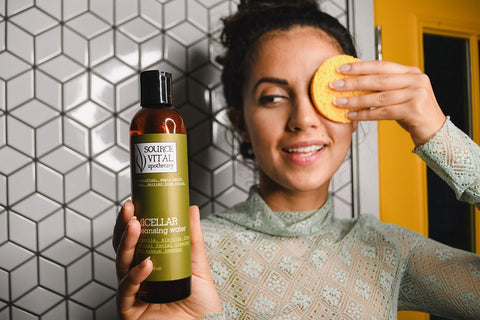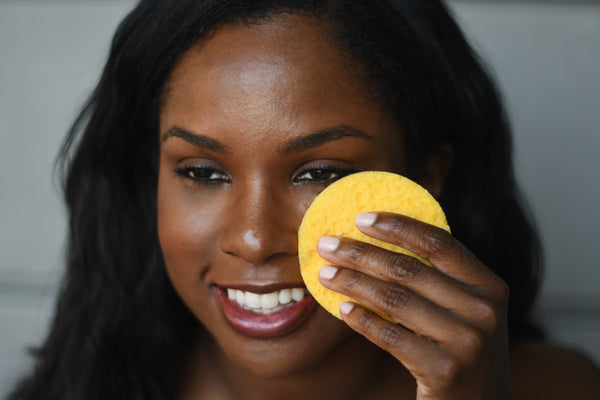The Benefits and Drawbacks of Cleansing Your Skin With a Sponge

We all want to have clean and clear skin, but with so many different skincare tools and methods available, it can be overwhelming to decide what works best for us. One popular tool for cleansing the skin is the facial sponge. Facial sponges come in a variety of materials, shapes, and sizes, and have been praised for their gentle exfoliating and deep cleansing properties. However, like any skincare tool, there are pros and cons to using a facial sponge.
Let’s explore the benefits and drawbacks of incorporating a facial sponge into your skincare routine.

The Benefits of Cleansing the Skin With A Sponge
Gentle Exfoliation
One of the primary benefits of using a facial sponge is that it provides gentle exfoliation. Exfoliation is the process of removing dead skin cells from the surface of the skin. When dead skin cells accumulate, they can clog pores and cause breakouts. Exfoliating regularly can help to prevent these issues and leave your skin looking smoother and more radiant.
Facial sponges provide a gentle form of exfoliation that is suitable for all skin types, including sensitive skin. The sponge helps to buff away dead skin cells without causing irritation or damage to the skin.
Deep Cleansing
Facial sponges are also effective at removing dirt, oil, and other impurities from the skin. When used with a cleanser, the sponge can help to break down and remove dirt and oil that may be trapped in the pores.
This deep cleansing can help to prevent breakouts and promote clearer skin. It can also help to remove makeup more effectively than just using your hands, ensuring that your skin is clean and free from impurities before applying other skincare products
Improved Absorption of Skincare Products
Using a facial sponge can help to improve the absorption of other skincare products, such as serums and moisturizers. When dead skin cells are removed, these products can penetrate the skin more easily and provide better results.
This is especially true for products that contain active ingredients, such as retinol or vitamin C. These ingredients need to penetrate the skin in order to be effective, and using a facial sponge can help to ensure that they are able to do so.
Environmentally Friendly
Many facial sponges are made from natural materials, such as vegetal ingredients, or sea sponges, making them an eco-friendly option for cleansing your skin. At Source Vitál, we offer Natural Cellulose Sponges, made of ingredients such as wood pulp, flax, and cotton. They absorb and hold liquid well and can last through some fairly tough cleaning jobs. The sponges come "flat". All you have to do is add water and they'll expand. Best of all, they are biodegradable and can be composted after use, reducing the amount of waste that ends up in landfills.
The Drawbacks of Cleansing With A Sponge
Bacterial Growth
One of the potential drawbacks of using a facial sponge is that it can harbor bacteria if not cleaned and stored properly. Bacteria can accumulate on the surface of the sponge, especially if it is used frequently or left damp.
This can lead to skin irritation, breakouts, and even infections. To prevent bacterial growth, it is important to clean your facial sponge after each use and allow it to dry completely before storing it.
Over-Exfoliation
While gentle exfoliation can be beneficial for the skin, over-exfoliation can cause damage and irritation. Using a facial sponge too frequently or applying too much pressure can lead to redness, dryness, and flaking.
This is especially true for those with sensitive skin, as they may be more prone to irritation. To avoid over-exfoliating, it is important to use your facial sponge no more than two to three times per week and to apply gentle pressure when using it.
Maintenance
Facial sponges require regular cleaning and maintenance in order to keep them in good condition. This can be a drawback for those who prefer low-maintenance skincare routines.
To clean your facial sponge, you should rinse it thoroughly with warm water after each use and hang it to dry in a well-ventilated area. You can also disinfect it by soaking it in a solution of water and vinegar or tea tree oil once a week. Additionally, you should replace your facial sponge every three to four months, as it can start to break down and harbor bacteria over time.
Not Suitable for All Skin Types
While facial sponges are generally suitable for all skin types, they may not be the best choice for everyone. Those with extremely sensitive skin or conditions such as eczema may find that the exfoliation and friction from using a facial sponge are too harsh and irritating for their skin.
It is important to listen to your skin and discontinue use if you experience any discomfort or irritation. Facial sponges can be an effective and affordable tool for achieving clean and clear skin. Their ability to gently exfoliate and deeply cleanse can leave the skin looking brighter and smoother. However, it is important to consider the potential drawbacks of using a facial sponge, such as bacteria build-up, possible over-exfoliation, and the fact they aren’t one size fits all. Ultimately, whether or not to use a facial sponge is a personal decision that should be based on your individual skin type, preferences, and needs.
What questions do you have about using a facial sponge to cleanse your skin? Let us know in the comments!


Leave a comment